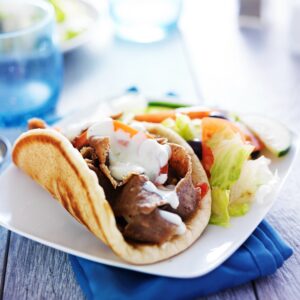Welcome to the world of Greek cuisine, where the flavors are as vibrant as the culture. Today, we’re delving into the making of Greek Gyros with Tzatziki Sauce, a dish that exemplifies the rich tradition and creativity embedded in Greek culinary practices. Throughout this journey, we’ll unravel the preparation techniques, and the culture and history surrounding this savory delight. So, brace yourselves for an enriching gastronomic adventure, replete with aromatic spices, succulent meat, and a sauce that dances on the palate.
But, to truly appreciate the Gyros, we must trace their roots back to their place of origin. Greece, a country renowned for its culinary prowess, is a trove of flavors and culinary customs that have evolved over the centuries. Among these, the city of Volos stands out with its unique culinary heritage. As we navigate through the intriguing aspects of Gyros and its birthplace, you’ll be equipped not only to create this delicious dish but also to appreciate its cultural significance. So, let’s embark on this journey, where food meets history and culture, and bring the essence of Greek cuisine right into your kitchen.
Table of contents
Mastering the Art of Greek Gyros
Immerse yourself in the essence of Greek cuisine as we embark on a journey to master the art of crafting the perfect Gyros. In its traditional avatar, Greek Gyros is a delicious assortment of tender, marinated meat, typically pork or chicken. This flavorful meat is expertly grilled on a vertical rotisserie, where it attains a beautiful caramelization and smoky flavor. The key here is slow cooking, which locks in the juices and ensures the meat is perfectly cooked. Once done, the meat is thinly sliced and served on warm, soft pita bread, providing a delightful contrast in textures.
As we move to the second phase of Gyros preparation, we introduce the vibrant hues and fresh flavors of vegetables. Crisp lettuce, ripe tomatoes, and tangy onions not only add a nutritional punch but also balance the richness of the meat. Then comes the signature Tzatziki sauce, a creamy, tangy complement to the robust flavors of the meat and veggies. However, the beauty of the Gyros truly shines in its versatility. While the traditional recipe is an undying classic, there are numerous variations to cater to different taste preferences.
Perhaps you prefer a vegetarian spin on the traditional Gyros? Replacing the meat with grilled vegetables offers a flavorful and wholesome alternative. Seafood enthusiasts can substitute meat with grilled fish or shrimp, adding a unique twist to the dish. Also, you can play around with the sauces. How about hummus or garlic aioli for a change from the classic Tzatziki sauce? Experimentation extends to the method of cooking as well. Although a vertical rotisserie is traditional, a stovetop pan or oven can be just as effective in a home kitchen. Embarking on this journey of culinary creativity, you’ll soon realize that mastering the art of Greek Gyros is not about rigidly following a recipe, but embracing the freedom to make it your own.
Preserving the Taste: How to Store Gyros Properly
Understanding the nuances of food storage is as crucial as the preparation itself, especially when it comes to preserving the freshness and taste of Greek Gyros. Let’s delve into the best practices for properly storing your homemade gyros to enjoy later. If you have leftovers, which is often unlikely given the deliciousness of the dish, it’s essential to cool them at room temperature before packing away. Avoid leaving them out for more than two hours as it can lead to bacterial growth.
Now, let’s consider the best way to package your leftovers. Wrap individual gyro sandwiches tightly in aluminum foil. This method helps to keep the contents intact and retains moisture, ensuring your gyro doesn’t dry out. For the meat, consider storing it separately in airtight containers to prevent it from becoming soggy. This method allows for easier reheating later, particularly if you prefer to warm the meat and vegetables separately.
Lastly, refrigeration is your next step. You should place your tightly wrapped gyros or separate components into the refrigerator as soon as they’re packed. Consumed within three to four days, they will maintain their best quality. But what if you want to keep them longer? The freezer is a viable option, where gyros can last up to two months, albeit with some loss of texture. To reheat, simply thaw in the refrigerator overnight and warm in an oven or stovetop pan, adding a dash of water to prevent drying out. Follow these steps, and you will master not only making Greek Gyros but also preserving their taste and freshness for future enjoyment.
The Cultural Journey of Gyros: A Historical Perspective
Gyros, with its savory grilled meat and flavorful accompaniments, has become a beloved dish worldwide. But to appreciate it fully, we must embark on a journey back to its origins. The history of the gyro is deeply rooted in Greece, where it has been a popular street food for centuries. The gyro, meaning ‘turn’ in Greek, got its name from the rotisserie style of cooking, where the meat is traditionally roasted vertically and thinly sliced.
As we delve further, we’ll find that the gyro’s origins trace back to the doner kebab from the Ottoman Empire. Turkish immigrants introduced the doner kebab to Greece, and over time, it evolved into what we now recognize as the Greek gyro. Greeks adopted this style of cooking, using local ingredients like pork and chicken, and added tzatziki, a creamy sauce made of yogurt, cucumber, and garlic, to enhance the flavor profile. This fusion of culinary practices ultimately gave birth to the gyro, which became an instant hit in Greece.
Gyros embarked on their global journey in the 1970s when Greek immigrants brought the dish to cities like Chicago and New York. The gyro’s popularity soared due to its delicious taste and convenience as a quick, handheld meal. From a local Greek street food to an international favorite, the gyro has certainly made a significant mark on the culinary world. Its story serves as a testament to the power of food in transcending borders and cultures, and in continuing to evolve while staying true to its roots.
Volos, Greece: The Heartland of Gyros
Nestled at the foot of Mount Pelion overlooking the Pagasetic Gulf, Volos, Greece serves as the heartland of gyros. As one of the country’s most attractive cities, Volos is not only renowned for its breathtaking natural beauty and fascinating mythology but is also acclaimed for its delectable cuisine. This vibrant port city, steeped in history and tradition, is where the magic of gyros truly comes to life.

Volos’ food culture is deeply ingrained in the everyday lives of its people, with gyros being a significant part of it. Walk down any street in Volos, and you’ll encounter enticing aromas wafting from bustling gyro shops. Here, traditional cooking techniques passed down through generations are put into practice. The pork or chicken, marinated in Greek herbs and spices, turns slowly on the vertical spit, cooked to perfection, ready to be thinly sliced, and served with fresh tzatziki sauce, vegetables, and warm pita bread.
But the city’s love for gyros goes beyond its taste. In Volos, gyros serve as a symbol of shared heritage and communal dining. It’s a meal that brings people together, whether for a quick lunch on a busy day or a leisurely dinner under the stars. Dining in Volos is not just about eating; it’s about embracing the joyous spirit of Greek hospitality. Volos, with its rich gyro culture, is a testament to Greece’s culinary legacy and the enduring allure of this delicious dish.
Unearthing Volos: A Historical Overview
Unveiling the history of Volos, Greece, requires peeling back layers of time, tracing the path of civilization from its ancient roots to its vibrant present. Situated in Thessaly, the city stands as a testament to various eras of Greek history. It is believed that the area was inhabited as early as the Neolithic period, around 6000 BC. Notably, the myths of Jason and the Argonauts and the Centaurs originate from this area, weaving a rich tapestry of Greek mythology into the city’s history.

The city, as we know it today, began to take shape in the 19th century. During this period, the city emerged as a significant commercial hub due to its strategic position. Over the years, Volos withstood numerous invasions and occupations, each leaving its unique mark on the city’s cultural and architectural landscape. By the 20th century, Volos had grown into one of Greece’s most important port cities, playing a pivotal role in the country’s trade and economy.
Today, Volos is a captivating blend of ancient history and modern life. With its well-preserved archaeological sites, vibrant markets, and bustling port, the city invites visitors to explore its rich history. The old city quarter, known as Palia, with its neoclassical buildings, tells tales of the city’s prosperous past. So, when you walk through the streets of Volos, you are not just exploring a city; you’re journeying through centuries of Greek history.
The Cultural Melting Pot: Diversity in Volos
Volos, as a city bustling with diversity, offers a unique and enchanting experience for tourists. This city, which stands as a testament to the harmonious blend of diverse cultures, enchants visitors with its vibrant energy and rich history. Whether you’re exploring ancient ruins, strolling through the bustling marketplaces, or experiencing the vibrant nightlife, Volos has something for every traveler.

Tourists to Volos find themselves immersed in the city’s rich cultural tapestry. The city streets are lined with a mix of Byzantine, neo-classical, and modern architecture, each telling its own story of the city’s past and present. Visitors can explore the Archaeological Museum of Volos for a deep dive into the region’s ancient history, or take a scenic stroll along the city’s vibrant waterfront lined with cafes and eateries offering local delicacies.
The city’s gastronomic scene is as diverse as its culture. From traditional tavernas serving delicious gyros to chic modern bistros offering international cuisines, there’s a dining experience to suit every palate in Volos. Meanwhile, the city’s lively festivals, art galleries, and music events offer a glimpse into the vibrant local culture. As the sun sets, the city transforms into a lively hub with bustling bars and nightclubs. No matter your interests, Volos promises an unforgettable journey of exploration and discovery.
Savoring Volos: A Culinary Exploration of the City’s Gastronomy
In Volos, gastronomy isn’t simply a matter of sustenance; it’s a vibrant expression of culture, tradition, and a love for life. The city’s cuisine reflects its diverse history and rich cultural influences, and each dish tells a story of its own. From the bustling markets brimming with fresh local produce to the rustic tavernas and upscale bistros, the culinary landscape of Volos is a delicious journey waiting to be savored.
Starting with street food, the local favorite, the iconic Greek gyro, is a must-try for any visitor. This hearty wrap of succulent meat, fresh vegetables, and creamy tzatziki, all encased in a soft, warm pita, is a testament to the city’s love for bold, flavorsome food. Another local delicacy is the mouthwatering “spetzofai,” a hearty stew of local sausages and peppers, a perfect showcase of the city’s rustic cuisine.
Venture into the city’s tavernas, and you’ll be greeted with a wealth of traditional Greek dishes that are steeped in tradition. Try “tsipouro,” the city’s beloved spirit, often enjoyed with “mezedes,” small plates of flavorful local dishes. Seafood is also a highlight in Volos, with its coastal location providing an abundant supply of fresh fish and shellfish. From grilled octopus to delectable fish soups, Volos is a seafood lover’s paradise. Whether you’re a seasoned foodie or a curious traveler, Volos offers a feast of experiences that will satisfy your palate and deepen your understanding of Greek culinary traditions.
– Featured Restaraunt –
Pyrostia – Grill – Souvlaki
“Πυροστιά” – Ψησταριά – Σουβλατζίδικο
Κ.Kartali 283, Volos 382 21, Greece

Taste perfectly cooked doner kebabs, souvlakia, and gyros. This restaurant is rated on Google 4.7 by its visitors.
Assembling Your Kitchen for Greek Gyros with Tzatziki Sauce
Embarking on the journey to create Greek Gyros with Tzatziki Sauce begins with setting up your kitchen effectively. Having the right tools and ingredients at your disposal not only ensures a smooth cooking experience but also brings you one step closer to authentically replicating the flavors of Greek cuisine. From the comfort of your home kitchen, you can transport your taste buds straight to the vibrant streets of Volos.
Firstly, let’s talk about equipment. You will need a good quality skillet or grill pan for cooking the gyro meat to perfection. If you wish to make your own pita bread, a reliable oven or a bread maker comes in handy. Other essential kitchen tools include a sharp chef’s knife for slicing the vegetables and meat, a cutting board, mixing bowls, and measuring spoons and cups for accuracy in flavors. And let’s not forget the grater for fresh cucumber in your Tzatziki sauce.
Moving on to ingredients, freshness is key in Greek cuisine. You will need lean cuts of chicken, pork, or beef for the gyros. Essential spices like oregano, garlic, rosemary, and thyme lend a characteristic flavor to the meat. Fresh vegetables like tomatoes, cucumbers, and onions add a refreshing crunch, while the creamy Tzatziki sauce ties everything together. To make this sauce, you’ll need Greek yogurt, fresh cucumber, garlic, and dill. Lastly, don’t forget the warm, fluffy pita bread to hold your delicious creation. Once your kitchen is equipped with these essentials, you’re ready to embark on your culinary adventure of making Greek Gyros with Tzatziki Sauce.
Kitchen Tools
- 2 Mixing Bowls
- 1 Baking Sheet
- 1 Knife
- 1 Box Grater
- 1 Garlic Press
For the Gyros
- 1 pound ground lamb
- 1 pound 80/20 ground beef
- 1 yellow onion finely chopped
- 1 teaspoon dried oregano
- 1 teaspoon dried thyme
- 1 teaspoon dried rosemary
- 2 teaspoons garlic powder
- salt
- black pepper
For the Tzatziki Sauce
- 1 large cucumber peeled and seeded
- 1 tablespoon lemon juice
- 1 tablespoon fresh dill chopped
- 2 cloves garlic minced
- 1 ½ cups Greek yogurt
- salt
- black pepper
To Serve
- pita bread
- tomatoes sliced
- red onions sliced
- feta cheese crumbled
Embarking on the Culinary Adventure: Making Your Greek Gyros with Tzatziki Sauce
Diving into the culinary art of creating Greek Gyros with Tzatziki sauce is an exhilarating gastronomical adventure. The journey begins with combining the lamb and beef, alongside finely chopped onion and a blend of herbs and spices such as oregano, thyme, rosemary, and garlic powder. It’s important to remember that blending these elements well is the secret to the rich, robust flavors characteristic of a traditional Greek gyro.
Once you’ve formed your mixture into logs, these flavor-packed parcels will bake until they’ve reached perfection. Let them cool slightly after removing them from the oven, then with a sharp knife in hand, you’ll transform the logs into thin, succulent strips, ready to tantalize your taste buds.
As your meat cools, you’ll find yourself turning toward the refreshing Tzatziki sauce. This involves grating a large cucumber, squeezing out the excess moisture, and combining it with lemon juice, chopped dill, minced garlic, and Greek yogurt. Your kitchen will be filled with a blend of fragrant aromas as you mix these together to create a tangy and creamy sauce. In the meantime, you’ll prepare the fresh vegetables and warm the pita bread. Once everything is set, the assembly begins. Layer your gyro meat onto the warm pita, add a generous dollop of your freshly made Tzatziki sauce, and garnish with sliced tomatoes, red onions, and crumbled feta cheese. You’ve now crafted an authentic Greek Gyro with Tzatziki Sauce, transporting your senses straight to the heart of Greek street food. Enjoy the journey!
Time needed: 1 hour and 35 minutes
How to Make Greek Gyros with Tzatziki Sauce
- For the Gyros
In a large bowl, combine ground lamb, ground beef, onion, oregano, thyme, rosemary, garlic powder, salt, and pepper. Mix well.
- Divide and Shape the Meat Logs
Divide the meat mixture into 6 portions and shape each into a log shape.
- Bake the Meat
Place the logs on a baking sheet and bake at 375°F for 30-40 minutes, until fully cooked.
- Cut the Meat
Once cooked, remove from the oven and let cool slightly. Using a sharp knife, slice the logs into thin strips.
- For the Tzatziki Sauce
Grate the cucumber using a box grater and squeeze out any excess moisture.
- Mix the Ingredients
In a medium bowl, combine grated cucumber, lemon juice, dill, garlic, Greek yogurt, salt, and pepper. Mix well.
- Cover and Cool the Tzatziki Sauce
Cover and refrigerate for at least 30 minutes before serving.
- Heat the Pita
Warm up some pita bread in the oven or on a grill.
- Build the Gyros
Finally, place the meat on one half of the pita, topped with tzatziki sauce, tomatoes, onions, and feta cheese.
- Serve the Gyros
Serve Homemade Greek Gyros with rice pilaf or a Greek salad, and enjoy!
If you liked this dish please Rate This Recipe and leave a comment.
Greek Gyros with Tzatziki Sauce
Please Rate this Recipe
Equipment
- 1 Knife
- 1 Box Grater
- 1 Garlic Press
Ingredients
For the Gyros:
- 1 pound ground lamb
- 1 pound 80/20 ground beef
- 1 yellow onion finely chopped
- 1 teaspoon dried oregano
- 1 teaspoon dried thyme
- 1 teaspoon dried rosemary
- 2 teaspoons garlic powder
- salt
- black pepper
For the Tzatziki Sauce:
- 1 large cucumber peeled and seeded
- 1 tablespoon lemon juice
- 1 tablespoon fresh dill chopped
- 2 cloves garlic minced
- 1 ½ cups Greek yogurt
- salt
- black pepper
To Assemble:
- pita bread
- tomatoes sliced
- red onions sliced
- feta cheese crumbled
Instructions
For the Gyros:
- In a large bowl, combine ground lamb, ground beef, onion, oregano, thyme, rosemary, garlic powder, salt, and pepper. Mix well.1 pound ground lamb, 1 pound 80/20 ground beef, 1 yellow onion, 1 teaspoon dried oregano, 1 teaspoon dried thyme, 1 teaspoon dried rosemary, 2 teaspoons garlic powder, salt, black pepper
- Divide the meat mixture into 6 portions and shape each into a log shape.
- Place the logs on a baking sheet and bake at 375°F for 30-40 minutes, until fully cooked.
- Once cooked, remove from the oven and let cool slightly. Using a sharp knife, slice the logs into thin strips.
For the Tzatziki Sauce:
- Grate the cucumber using a box grater and squeeze out any excess moisture.1 large cucumber
- In a medium bowl, combine grated cucumber, lemon juice, dill, garlic, Greek yogurt, salt, and pepper. Mix well.1 tablespoon lemon juice, 1 tablespoon fresh dill, 2 cloves garlic, 1 ½ cups Greek yogurt, salt, black pepper
- Cover and refrigerate for at least 30 minutes before serving.
To Assemble:
- Warm up some pita bread in the oven or on a grill.pita bread
- Top each pita with the sliced Gyros meat and drizzle with tzatziki sauce.
- Add some sliced tomatoes, red onion, and feta cheese, if desired.tomatoes, red onions, feta cheese
- Roll up the pita and enjoy!
Notes
- To make the Gyros extra juicy, you can add some finely grated onion or breadcrumbs to the meat mixture.
- Leftover Gyros meat can be stored in an airtight container in the fridge for 3-4 days or in the freezer for up to 2 months.
- When you are ready to enjoy it again, simply reheat in a skillet or in the oven.
- Serve with fresh pita bread and your favorite toppings for a quick and easy meal.
Nutrition
Complementing Your Feast: Recipes that Pair Perfectly with Greek Gyros with Tzatziki Sauce
As we dive into the vibrant world of Greek cuisine, it’s crucial to remember that a perfect meal isn’t just about a single, standalone dish. No, indeed, the beauty of a well-rounded Greek feast lies in the artful combination of flavors and textures that enhance and complement each other. With Greek Gyros taking the spotlight in our culinary journey, let’s explore some additional recipes that would beautifully round out your table and provide a complete, immersive Greek dining experience.
And there you have it, a harmonious symphony of tastes and aromas that each play their part in creating the perfect Greek feast. Each of these additional recipes was carefully selected to complement the star of the show – our Greek Gyros with Tzatziki sauce. Whether it’s the refreshing crunch of a Greek salad, the comforting warmth of a hearty soup, or the soft, smooth texture of a traditional dessert, these dishes all work in unison to accentuate the delightful flavors of the Gyros. So, gather your ingredients, prepare your kitchen, and embark on this unforgettable culinary journey. Kali Orexi – Bon Appétit!
Photo Credits:
- By Taste The World Cookbook – Copyright 2022 All rights reserved.
- By Tsints – IS club, CC BY-SA 3.0, https://commons.wikimedia.org/w/index.php?curid=10611483
- By Konstantinos Volanakis – [1], Public Domain, https://commons.wikimedia.org/w/index.php?curid=9069461
- By C messier – Own work, CC BY-SA 4.0, https://commons.wikimedia.org/w/index.php?curid=72842983


